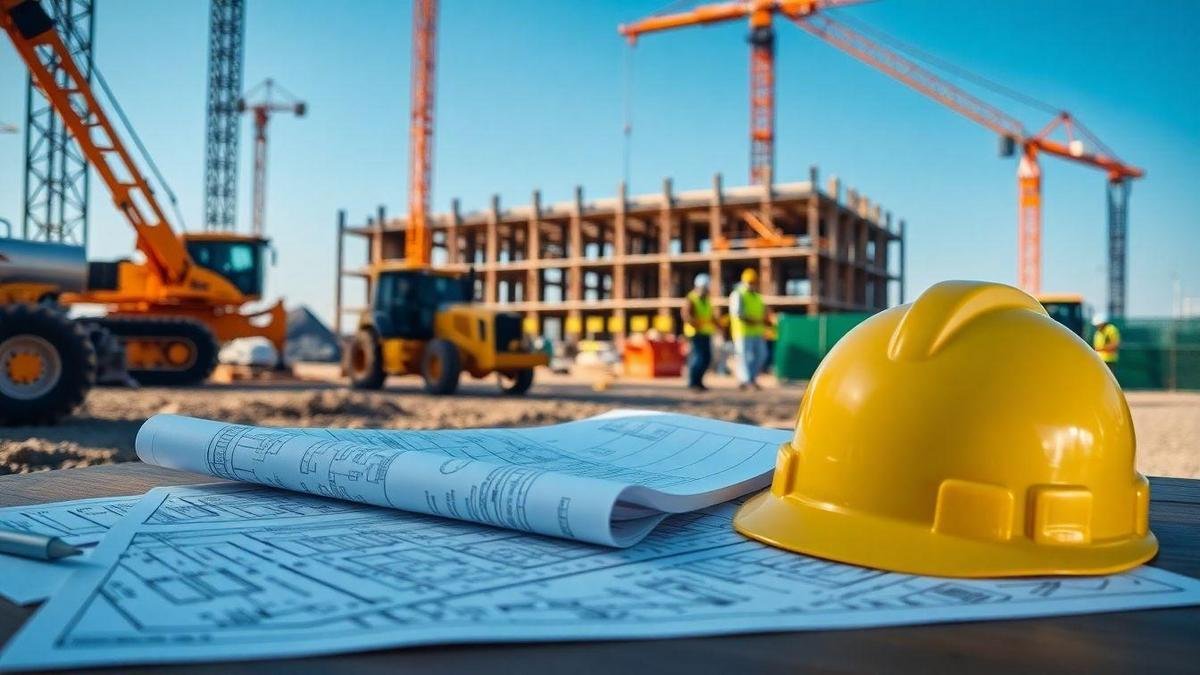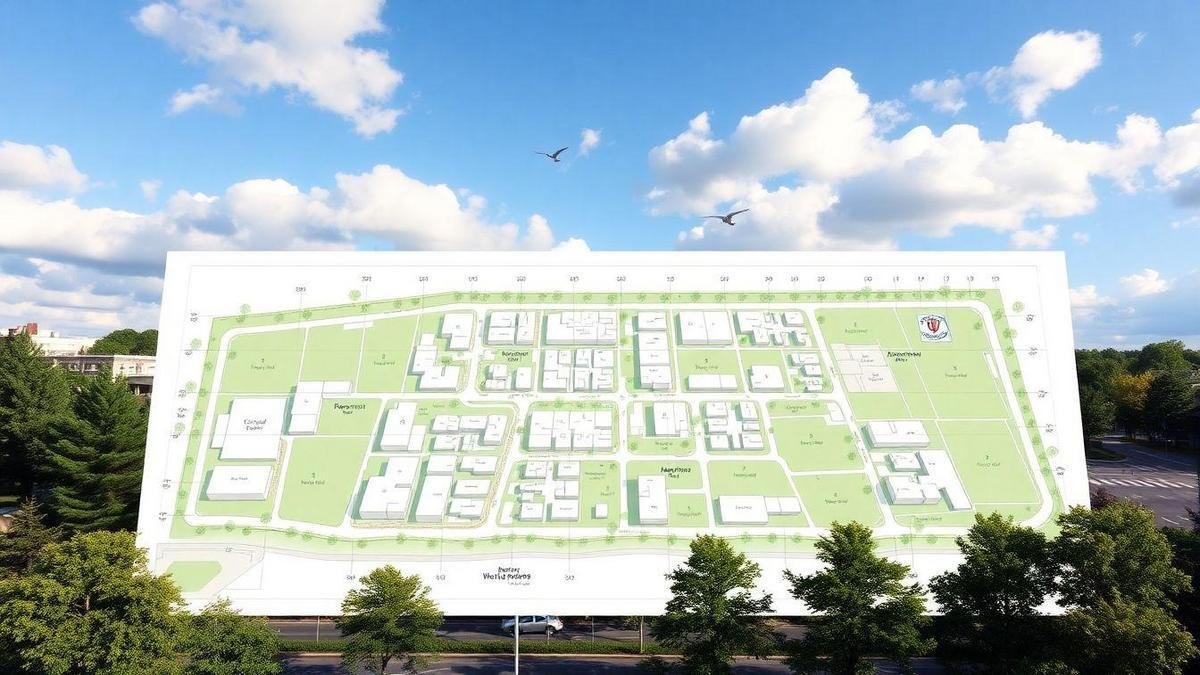The site plan approval process can seem tricky, but understanding it is vital for successful development. This article will guide readers through the key steps needed for site planning, including zoning regulations, land use approvals, and construction permits. It will highlight the importance of a well-structured site plan and how to navigate common challenges. With a focus on compliance and tips for faster approvals, this piece aims to simplify and clarify the approval journey.
Key Takeaways
- Understanding the site plan approval process helps with planning.
- Follow local rules to avoid delays.
- Prepare clear documents for faster approval.
- Communicate with officials for better results.
- Review feedback to improve future plans.

Understanding the Site Plan Approval Process
Key Steps in the Site Plan Approval Process
The site plan approval process is crucial for any land development project. It involves several key steps that guide developers from initial ideas to final approval. Here’s a breakdown of these steps:
- Pre-Application Meeting: Developers meet with local officials to discuss the project. This helps clarify requirements and expectations.
- Submission of Site Plan: Once the developer has a clear plan, they submit it for review. This plan must include details such as land use, building layouts, and environmental impacts.
- Review by Planning Staff: Local planning staff examines the site plan to check if it meets zoning laws, building codes, and other regulations.
- Public Hearing: A public hearing allows community members to voice their opinions. Feedback from the public can influence the final decision.
- Approval or Denial: After reviewing all information, the planning board makes a decision. If approved, the developer can move forward; if denied, they may need to revise the plan.
Importance of Site Planning in Development
Effective site planning is the backbone of successful land development. It not only helps in securing necessary approvals but also lays the groundwork for future growth. A well-thought-out site plan considers various factors, such as:
- Environmental Impact: Ensuring the project does not harm the local ecosystem.
- Traffic Flow: Planning for how vehicles and pedestrians will navigate the area.
- Utilities and Infrastructure: Ensuring access to water, electricity, and sewage systems.

Zoning Regulations and Their Impact
How Zoning Regulations Affect Site Planning
Zoning regulations play a crucial role in the site plan approval process. They dictate how land can be used, which directly impacts the design and layout of a project. For example, if a piece of land is zoned for residential use, developers must design their plans to include homes, parks, or schools, rather than commercial buildings.
These regulations can also affect the density of a project. A developer may want to build a high-rise apartment complex, but if the zoning restricts building height, they must adjust their plans accordingly. This can lead to changes in the number of units or the overall design, which may not align with the original vision.
Common Zoning Challenges in the Approval Process
Zoning challenges can arise at any stage of the approval process. Some common issues include:
- Non-conformance: When a proposed project does not meet existing zoning laws.
- Variances: Requests for exceptions to zoning rules can be time-consuming and uncertain.
- Community Opposition: Local residents may oppose a project due to concerns about traffic, noise, or changes to their neighborhood.
These challenges can delay projects and increase costs. Developers must be prepared to address these issues head-on.
Navigating Zoning Laws for Successful Approvals
To successfully navigate zoning laws, developers should consider the following strategies:
- Research Local Regulations: Understanding the specific zoning laws that apply to a project is essential. This includes knowing the requirements for setbacks, building heights, and land use.
- Engage with the Community: Building relationships with local residents and stakeholders can help mitigate opposition. Holding community meetings to discuss plans can foster goodwill.
- Work with Experts: Hiring zoning consultants or attorneys who specialize in land use can provide valuable insights and streamline the approval process.
By adopting these strategies, developers can enhance their chances of obtaining the necessary approvals and moving their projects forward.

The Role of Land Use Approval
What is Land Use Approval?
Land Use Approval refers to the official permission granted by local government authorities to develop a specific piece of land for a designated purpose. This process ensures that the proposed development aligns with local zoning laws and regulations. It is a vital step for any investor or developer looking to transform raw land into a viable project. Without this approval, any development plans may face significant delays or even outright rejection.
The Connection Between Land Use and Site Development
The site plan approval process is closely tied to land use approval. This connection is crucial because it outlines how the land can be utilized. For instance, if a developer wishes to build a shopping center, they must first receive land use approval to confirm that the zoning allows for commercial activity. This step is not just a formality; it shapes the project from the ground up.
| Aspect | Land Use Approval | Site Development |
|---|---|---|
| Purpose | Verify zoning compliance | Detail project layout |
| Process | Application & review | Submission of site plans |
| Outcome | Approval or denial | Detailed construction guidelines |
Ensuring Compliance with Land Use Regulations
To navigate the land use approval process successfully, it is essential to be aware of local regulations. Each municipality may have different rules, and these can change over time. Developers should conduct thorough research and possibly consult with local planning officials. This proactive approach can help avoid costly mistakes and delays.
In practice, compliance might involve:
- Submitting necessary documents: This could include environmental assessments or traffic studies.
- Public hearings: Engaging with the community can provide valuable feedback and foster goodwill.
- Revisions based on feedback: Flexibility can lead to a better project outcome.

Streamlining the Permit Process
Steps to Simplify the Permit Process
Navigating the site plan approval process can often feel like walking through a maze. To make things easier, investors should follow these steps:
- Research Local Regulations: Understanding local laws is crucial. Each area has its own rules that can affect the permit process.
- Prepare Comprehensive Documents: Investors must gather all necessary documents, such as site plans, environmental reports, and surveys. Clear and complete submissions can speed up approvals.
- Engage with Local Authorities Early: Early discussions with local officials can clarify requirements and expectations. This proactive approach can save time later on.
- Utilize Technology: Many jurisdictions offer online portals for permit submissions. Using these tools can streamline the process and reduce delays.
Common Delays in the Site Plan Approval Process
Delays can be a thorn in the side of any investor. Here are some common issues that can slow down the site plan approval process:
| Delay Type | Description |
|---|---|
| Incomplete Applications | Missing documents can halt the process. |
| Changes in Local Regulations | New laws can change requirements unexpectedly. |
| Environmental Concerns | Additional studies may be needed if environmental issues arise. |
| Public Opposition | Community pushback can lead to longer review times. |
Tips for Faster Permit Approvals
To help speed things along, investors can consider these practical tips:
- Be Clear and Concise: Providing straightforward information can help reviewers make quicker decisions.
- Stay Engaged: Regular follow-ups with local authorities can keep the process moving.
- Consult Professionals: Hiring experts who know the local landscape can help navigate potential pitfalls.
By implementing these strategies, investors can improve their chances of a smoother and faster site plan approval process.

Understanding Construction Permits
Types of Construction Permits Required
When embarking on a construction project, various construction permits play a crucial role. These permits can differ based on location and project type. Here’s a breakdown of the most common types:
| Permit Type | Description |
|---|---|
| Building Permit | Required for new buildings or major renovations. |
| Electrical Permit | Needed for any electrical work, ensuring safety standards. |
| Plumbing Permit | Required for plumbing installations or modifications. |
| Zoning Permit | Ensures the project complies with local zoning laws. |
| Environmental Permit | Needed if the project impacts the environment. |
Each of these permits serves a specific purpose, contributing to the overall safety and legality of a construction project.
The Importance of Construction Permits in Development
Construction permits are not just red tape; they are vital for successful development. They provide a framework that protects both the developer and the community. By obtaining the necessary permits, developers can:
- Avoid costly fines: Working without permits can lead to significant penalties.
- Enhance safety: Permits require adherence to safety standards, reducing risks.
- Boost property value: Properly permitted projects often see higher market values.
In essence, construction permits act as a foundation for a project’s success, guiding developers through the often intricate site plan approval process.
Ensuring Compliance with Construction Standards
Staying compliant with construction standards is paramount. This compliance does not just safeguard against legal troubles; it also enhances the quality of the final product. Following these standards can lead to:
- Higher quality builds: Adhering to codes ensures durability and safety.
- Increased community trust: Compliance fosters goodwill among neighbors and stakeholders.
- Streamlined inspections: Projects that meet standards often pass inspections on the first try.
In conclusion, understanding and navigating the landscape of construction permits is essential for any developer. It lays the groundwork for successful projects, ensuring safety and compliance while ultimately leading to a more prosperous investment.

Project Approval Workflow
Stages of the Project Approval Workflow
The site plan approval process is a critical journey for any land development project. It involves several stages that must be followed to achieve successful project approval. Here are the key stages:
- Initial Planning: This is where the groundwork is laid. Developers outline their ideas and gather preliminary information about the site.
- Submission of Plans: After initial planning, the developer submits detailed plans to the relevant authorities. This includes site plans, environmental assessments, and other necessary documents.
- Review Process: The submitted plans undergo a thorough review by various departments. This stage often involves feedback and requests for changes.
- Public Hearing: In many cases, a public hearing is held to gather community input. This is an important step as it allows the public to voice their opinions.
- Final Approval: Once all feedback is addressed, the project receives final approval. This means the developer can move forward with construction.
Key Stakeholders in the Approval Process
The approval process involves several key stakeholders, each playing a vital role. Here’s a breakdown:
| Stakeholder | Role |
|---|---|
| Developers | Initiate the project and submit plans. |
| Local Authorities | Review and approve the plans. |
| Community Members | Provide feedback during public hearings. |
| Environmental Agencies | Ensure compliance with regulations. |
Enhancing Communication for Efficient Approvals
Effective communication is essential for a smooth approval process. Stakeholders should keep an open line of dialogue. Regular updates and meetings can help address concerns early on. For instance, developers might hold community forums to explain their plans and gather input. This proactive approach can lead to faster approvals and a more positive relationship with the community.

Planning Compliance and Its Importance
What is Planning Compliance?
Planning compliance refers to the adherence to local, regional, and national regulations when developing land. It is crucial for investors to understand that these regulations are in place to ensure that developments are safe, environmentally sound, and beneficial to the community. Compliance involves following zoning laws, building codes, and environmental regulations. This process is not just a formality; it is a critical aspect of land development that can significantly impact the success of a project.
Ensuring Compliance Throughout the Site Plan Approval Process
Navigating the site plan approval process requires a clear understanding of the steps involved. Here are some key points to consider:
- Pre-Application Meetings: Engaging with local authorities early can provide valuable insights into what will be required.
- Documentation: Preparing all necessary documents, including surveys, environmental assessments, and architectural plans, is essential.
- Public Hearings: Being ready to present the project at public hearings can help address community concerns and foster support.
- Revisions: Be prepared to make changes to the plan based on feedback from authorities and the community.
By following these steps, developers can maintain compliance and keep the project moving forward.
Consequences of Non-Compliance in Development
Failing to comply with planning regulations can lead to serious consequences:
| Consequence | Description |
|---|---|
| Fines | Financial penalties can be imposed for violations. |
| Delays | Projects may face significant delays due to legal challenges. |
| Revocation of Permits | Non-compliance can lead to the loss of necessary permits. |
| Community Backlash | Local opposition can arise, damaging the project’s reputation. |
These consequences can derail a project and lead to financial losses. Therefore, understanding and adhering to planning compliance is essential for successful land development.

Regulatory Process and Its Challenges
Overview of the Regulatory Process in Site Planning
The regulatory process in site planning is crucial for land development. It involves several steps that developers must follow to get their projects approved. This process typically includes submitting a site plan, which outlines how the land will be used. Local governments review these plans to ensure compliance with zoning laws, environmental regulations, and community standards.
The process often starts with pre-application meetings where developers can discuss their plans with local officials. This is an important step, as it allows them to understand what is needed for approval. After that, the developer submits the site plan for formal review. The timeline for this process can vary, sometimes taking months or even years, depending on the complexity of the project and local regulations.
Common Regulatory Hurdles in the Approval Process
Developers often face several challenges during the site plan approval process. Here are some common hurdles:
- Zoning Issues: The land may not be zoned for the intended use, requiring a zoning change.
- Environmental Concerns: Projects may need to undergo environmental assessments, which can delay approval.
- Community Opposition: Local residents may oppose the development, leading to public hearings and additional reviews.
- Permit Requirements: There may be multiple permits needed, each with its own set of regulations and timelines.
These challenges can create a roadblock for investors looking to develop land efficiently.
Strategies for Overcoming Regulatory Challenges
To navigate the regulatory landscape effectively, developers can adopt several strategies:
- Early Engagement: Meeting with local officials early can help identify potential issues before they become major problems.
- Thorough Research: Understanding local regulations and community concerns can streamline the approval process.
- Community Outreach: Engaging with residents and addressing their concerns can reduce opposition and foster support.
- Professional Assistance: Hiring consultants with experience in the regulatory process can provide valuable insights and guidance.
By employing these strategies, developers can improve their chances of successfully navigating the site plan approval process.

Benefits of Smart Land Development
How Smart Land Development Enhances Site Planning
Smart land development boosts site planning by integrating technology and data. This approach allows developers to visualize projects better and make informed decisions. For instance, using Geographic Information Systems (GIS) helps identify the best locations for new developments. It also helps in understanding environmental impacts and community needs.
With smart land development, planners can collaborate more effectively. They can share information easily, which leads to better communication among stakeholders. This collaboration often results in designs that meet both regulatory requirements and community expectations.
Long-Term Advantages of Effective Site Plan Approval
Effective site plan approval can lead to sustainable growth and increased property values. By following a structured approval process, developers can minimize risks and avoid costly mistakes. Here are some long-term advantages:
| Advantage | Description |
|---|---|
| Increased Property Value | Well-planned sites tend to attract higher prices. |
| Reduced Development Time | A clear plan streamlines the approval process. |
| Community Satisfaction | Engaging with the community leads to better outcomes. |
| Environmental Benefits | Sustainable practices promote ecological health. |
Investors who focus on the site plan approval process can position themselves for success. They can save time and resources while maximizing the potential of their investments.
Investing in Sustainable Development Practices
Investing in sustainable development practices is crucial for long-term success. It not only meets current market demands but also prepares for future challenges. Sustainable practices can include:
- Energy-efficient buildings
- Green spaces
- Water conservation systems
These practices often lead to lower operating costs and increased tenant satisfaction. For example, a building designed with energy efficiency in mind can save thousands on utility bills each year. This not only benefits the environment but also boosts the bottom line for investors.
Conclusion
In conclusion, navigating the site plan approval process is essential for developers aiming for successful land development. Understanding the intricacies of zoning regulations, land use approvals, and construction permits can make the difference between a smooth project and a delayed one. By prioritizing compliance, engaging with local authorities, and preparing thorough documentation, developers can enhance their chances of receiving timely approvals. The journey may be fraught with challenges, but with the right strategies, it can also lead to sustainable growth and increased property values. As the saying goes, “Well begun is half done.” Therefore, a solid foundation in site planning will pave the way for future success. For more insightful articles on land development, visit Land Development Hub.

No responses yet